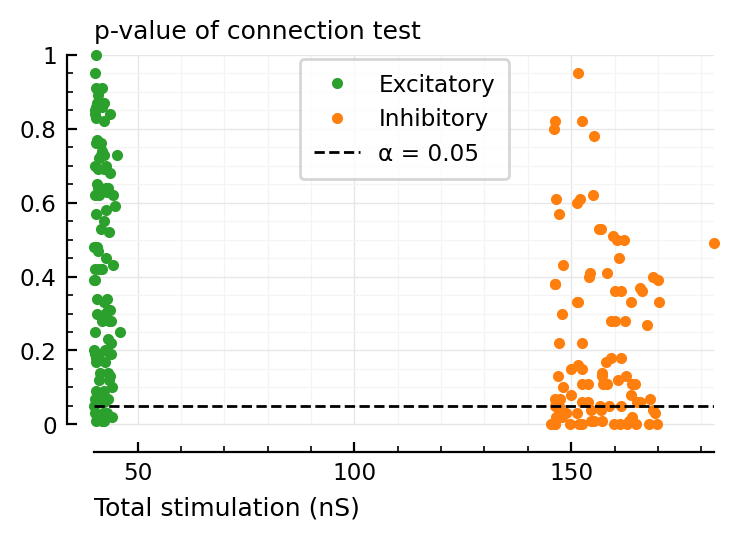2022-03-28 • The invariant measure: total stimulation
Contents
2022-03-28 • The invariant measure: total stimulation¶
Setup¶
#
using Revise
using MyToolbox
using VoltageToMap
[ Info: Precompiling VoltageToMap [b3b8fdc5-3c26-4000-a0c8-f17415fdf48e]
Params & sim¶
Short warm-up run. Get compilation out of the way.
p0 = ExperimentParams(
sim = SimParams(
input = previous_N_30_input,
duration = 1 * minutes
)
);
@time sim(p0.sim);
2.621567 seconds (7.21 M allocations: 512.827 MiB, 5.08% gc time, 92.06% compilation time)
p = ExperimentParams(
sim = SimParams(
input = realistic_N_6600_input,
duration = 10 * minutes,
synapses = SynapseParams(
Δg_multiplier = 0.066,
),
imaging = get_VI_params_for(
cortical_RS,
spike_SNR = Inf
),
)
);
dumps(p)
ExperimentParams
rngseed: 22022022
sim: SimParams
duration: 600.0
Δt: 0.0001
num_timesteps: 6000000
rngseed: 0
input: PoissonInputParams
N_unconn: 100
N_exc: 5200
N_inh: 1300
N_conn: 6500
N: 6600
spike_rates: LogNormal
μ: 1.08629
σ: 0.774597
synapses: SynapseParams
Δg_exc: 4.0e-10
Δg_inh: 1.6e-9
Δg_multiplier: 0.066
E_exc: 0.0
E_inh: -0.065
g_t0: 0.0
τ: 0.007
izh_neuron: IzhikevichParams
C: 1.0e-10
k: 7.0e-7
v_rest: -0.06
v_thr: -0.04
a: 30.0
b: -2.0e-9
v_peak: 0.035
v_reset: -0.05
Δu: 1.0e-10
v_t0: -0.06
u_t0: 0.0
imaging: VoltageImagingParams
spike_SNR: Inf
spike_SNR_dB: Inf
spike_height: 0.095
σ_noise: 0.0
conntest: ConnTestParams
STA_window_length: 0.1
num_shuffles: 100
rngseed: 22022022
evaluation: EvaluationParams
num_tested_neurons_per_group: 40
rngseed: 22022022
t, v, vimsig, input_spikes, state = @time sim(p.sim);
Progress: 100%|█████████████████████████████████████████| Time: 0:02:43
163.653968 seconds (18.23 M allocations: 2.300 GiB, 0.39% gc time, 0.00% compilation time)
num_spikes = length.(input_spikes)
ComponentVector{Int64}(conn = (exc = [1228, 940, 1389, 948, 509, 997, 831, 527, 1041, 876 … 1059, 997, 1200, 1103, 350, 585, 1106, 386, 1203, 798], inh = [470, 979, 876, 183, 882, 746, 1152, 1032, 201, 661 … 1287, 677, 865, 576, 1076, 1185, 1101, 1065, 927, 1334]), unconn = [908, 983, 717, 1052, 1400, 946, 680, 1444, 759, 612 … 1435, 868, 854, 329, 1235, 1300, 1394, 725, 505, 390])
Plot¶
import PyPlot
using VoltageToMap.Plot
tzoom = [200, 1200]ms
ax = plotsig(t, vimsig / mV, tzoom; xlabel="Time (s)", hylabel="mV", alpha=0.7);
plotsig(t, v / mV, tzoom; ax);
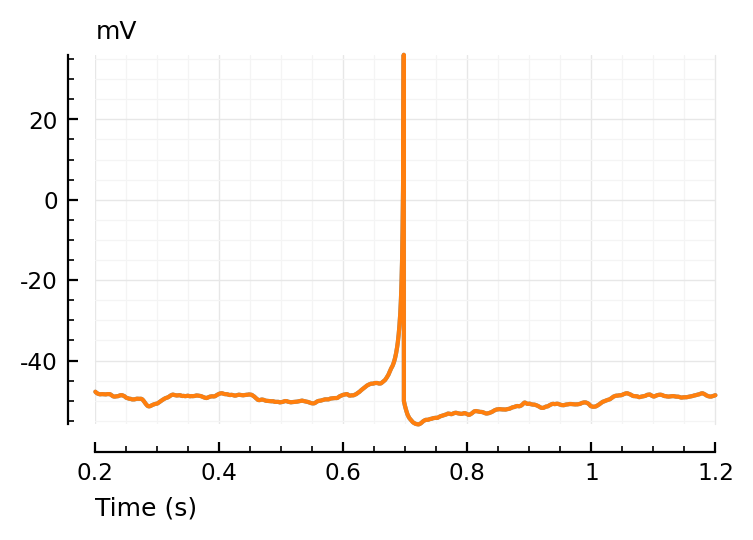
(Perfect overlap of Vm and VI sig: ∞ SNR)
Total stimulation¶
total_stim = num_spikes.conn .* state.fixed_at_init.Δg
round.(total_stim / nS)
ComponentVector{Float64}(exc = [32.0, 25.0, 37.0, 25.0, 13.0, 26.0, 22.0, 14.0, 27.0, 23.0 … 28.0, 26.0, 32.0, 29.0, 9.0, 15.0, 29.0, 10.0, 32.0, 21.0], inh = [50.0, 103.0, 93.0, 19.0, 93.0, 79.0, 122.0, 109.0, 21.0, 70.0 … 136.0, 71.0, 91.0, 61.0, 114.0, 125.0, 116.0, 112.0, 98.0, 141.0])
style = copy(sciplotlib_style)
style["xaxis.labellocation"] = "right"
set_mpl_style!(style);
fig, ax = plt.subplots()
ax.hist(total_stim.exc / nS, color="C2", label="Excitatory")
ax.hist(total_stim.inh / nS, color="C1", label="Inhibitory")
ax.set_xlim(left=0)
set(ax, xlabel="Total stimulation (nS)", ylabel="# Input connections")
ax.legend();
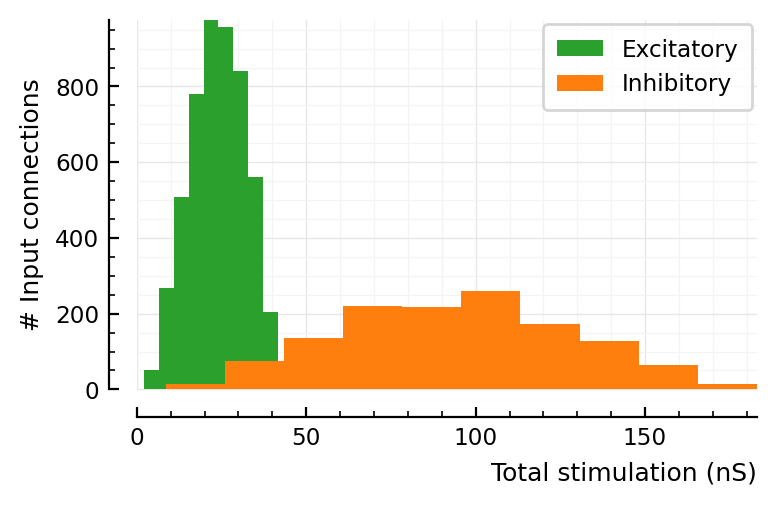
ax = plot(total_stim.exc / nS, num_spikes.conn.exc, "C2.", clip_on=false)
ax = plot(total_stim.inh / nS, num_spikes.conn.inh, "C1.", ax, clip_on=false)
ax.set_xlim(left=0)
ax.set_ylim(bottom=0)
set(ax, hylabel="# spikes", xlabel="Total stimulation (nS)");
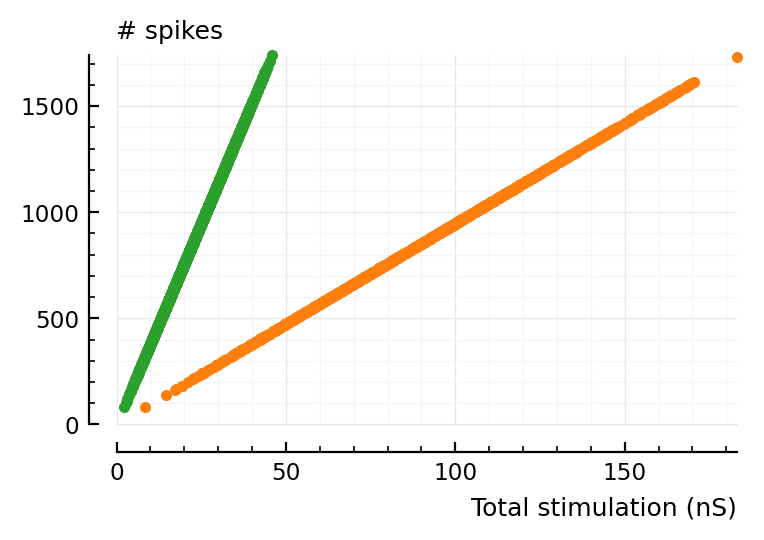
p-values¶
Testing all input connections takes too long. So we want to select only the most stimulating ones.
N_selected_per_class = 100;
get_indices_of_N_highest(arr, N) = partialsortperm(arr, 1:N, rev = true) # = `maxk` in matlab
strongest_exc = get_indices_of_N_highest(total_stim.exc, N_selected_per_class)
strongest_inh = get_indices_of_N_highest(total_stim.inh, N_selected_per_class);
chosen_exc = strongest_exc
chosen_inh = strongest_inh;
No actually let’s take random sample.
chosen_exc = 1:N_selected_per_class
chosen_inh = 1:N_selected_per_class;
total_stim__sel = CVec(
exc = total_stim.exc[chosen_exc],
inh = total_stim.inh[chosen_inh]
)
input_spike_trains__sel = (
exc = input_spikes.conn.exc[chosen_exc],
inh = input_spikes.conn.inh[chosen_inh],
); # no CVec (as components are arrays, not scalars).
p_values = similar(total_stim__sel, Float64)
@showprogress 400ms for (i, presynspikes) in enumerate(input_spike_trains__sel.exc)
p_values.exc[i] = test_connection(vimsig, presynspikes, p)
end
@showprogress 400ms for (i, presynspikes) in enumerate(input_spike_trains__sel.inh)
p_values.inh[i] = 1 - test_connection(vimsig, presynspikes, p)
end
Progress: 100%|█████████████████████████████████████████| Time: 0:00:08
Progress: 100%|█████████████████████████████████████████| Time: 0:00:07
Plot¶
ax = plot(total_stim__sel.exc / nS, p_values.exc, "C2.", label="Excitatory", clip_on=false)
ax = plot(total_stim__sel.inh / nS, p_values.inh, "C1.", ax, label="Inhibitory", clip_on=false)
α = 0.05
ax.axhline(α, color="black", zorder=3, lw=1, linestyle="dashed", label=f"α = {α:.3G}")
set(ax, xlabel="Total stimulation (nS)", hylabel="p-value of connection test", ylim=[0,1])
ax.legend(loc="upper left", bbox_to_anchor=(0.7, 1));
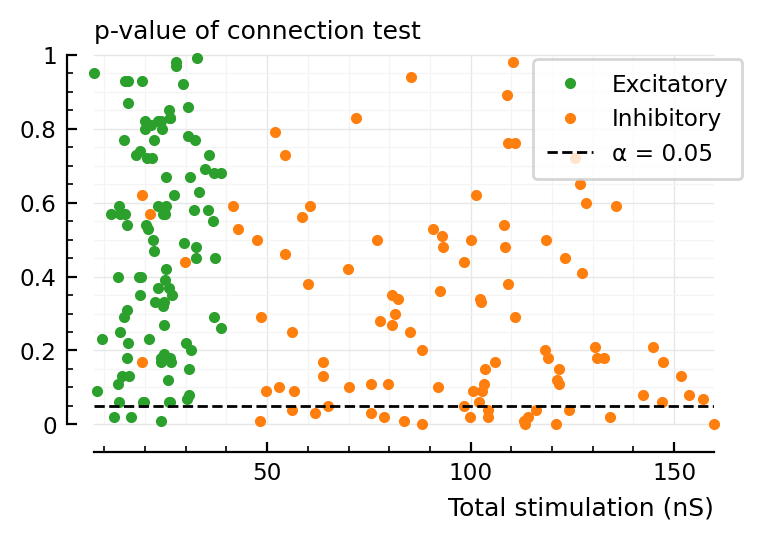
^ is for a random selection of inputs.
The below is for the N strongest inputs:
# (rerun and lose)
